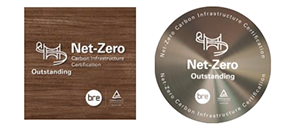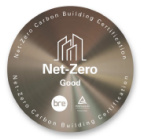
- NetZ Certification
- BESTi Certification
- News
- Q&A
NetZ Certification –
Net-Zero Carbon Infrastructure Evaluation and Certification (Pioneer Edition)
In recent years, countries have increasingly recognised the importance of managing carbon emissions from infrastructure, especially in the international context of achieving “net-zero” emission targets. The UK government’s analysis of infrastructure carbon emissions concluded that sectors such as transport, water, waste, energy, and communications account for more than 50% of national carbon emissions, with this proportion expected to increase significantly over the coming decades. Within the BREEAM system designated by the Building Research Establishment (BRE) of the UK, an evaluation of infrastructure sustainability has been officially incorporated – BREEAM INFRASTRUCTURE (formerly the CEEQUAL standard). GRESB began separating infrastructure from real estate in its scoring system in 2016, allowing investment managers to more effectively assess the sustainability performance of different types of assets.
The “Net-Zero Carbon Infrastructure Evaluation Scheme”, jointly launched by TÜV Rheinland (Germany) and the BRE, is designed to audit the low-carbon attributes of infrastructure, serve as a guide for promoting low-carbon design in infrastructure, and implement low-carbon management practices within project teams. The Pioneer Edition of this standard applies to roads, bridges, tunnels, and underground utility corridors, with additional categories such as power distribution projects, flood defence facilities, railway stations, and energy facilities to be added later.
TÜV Rheinland Greater China
Contact:Leon Zhang
Tel:021-60811991
Mobile:18703861902
Email:leon.zhang@tuv.com
Online application
The Net-Zero Carbon Infrastructure Assessment Standard Pioneer Edition evaluates the sustainable development planning and implementation of infrastructure projects through five major sections: basic information, personnel management, contractor management, low-carbon assessment (design, construction, embodied carbon emissions, operational carbon emissions), and innovation. This evaluation covers four stages and is applicable to both under-construction and existing infrastructure projects.
Notes: 1) The Net-Zero Carbon Infrastructure Evaluation Standard Pioneer Edition came into official use on 1 April 2024.
Our Core Advantages
- Dual professional assurance from international authoritative certification bodies and international building standards organisations with over a century’s experience.
- The first net zero carbon infrastructure evaluation standard and certification service in China.
- A dual-dimensional assessment including the quantification of project carbon emissions and evaluation of low-carbon management systems, conducting carbon emission audits for infrastructure projects.
- Focused on operational maintenance, ensuring the continuous achievement of infrastructure project decarbonisation goals through annual surveillance audits for sustainable realisation.




















